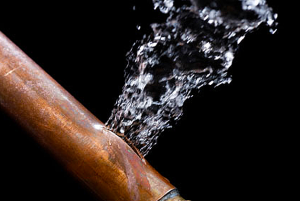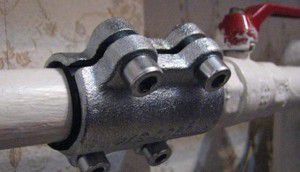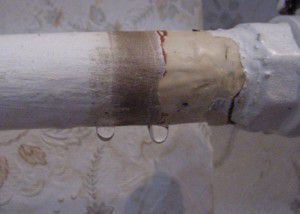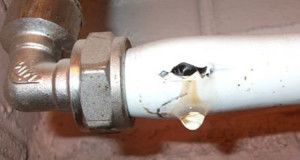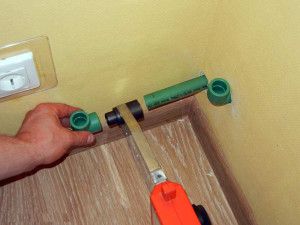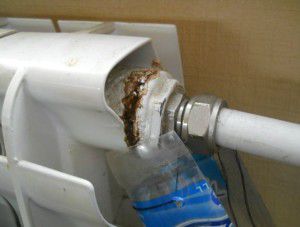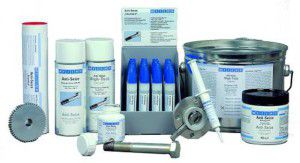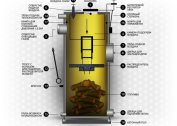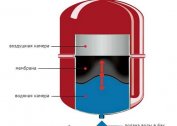Problems with the tightness of heating can occur at any time. There are many reasons for this - starting from improper installation and ending with exceeding the operational period. Regardless of this, we first eliminate the leak in the heating: pipes, radiators, batteries. And only then can a comprehensive system repair be done.
Causes of leakage in radiators and methods for its search
What to do if the heating radiator is flowing, and the water in the pipes is clearly above room temperature? To be prepared for such a situation, you should find out the cause of the loss of tightness of pipes and batteries.
The appearance of leaks in the heating system is due to special operating conditions. Water adversely affects the metal components of the system. And then the question arises - how to seal a leak in a heating battery? It is also necessary to take into account the thermal effect and periodic pressure drops in the pipelines.
There are several objective factors due to which the heating battery flows:
- System malfunction. A critical increase in temperature provokes an increase in pressure. This can lead to rupture at the joints of pipes or thin-walled batteries;
- Corrosion of steel system components. The relatively high air content in the water causes rusting of the inner surface of metal pipes and radiators;
- Water freezing, which leads to the appearance of ice plugs, which expand to burst pipes.
Before closing a leak in a heating pipe, it should be detected. If everything is okay visually with the system, this does not mean that there is no hidden impulse. How to find a leak in the heating system and what indicates its presence? The first indicator is a constant decrease in pressure and coolant volume in the system. If the automatic mixing unit is switched on at regular intervals, it means that the coolant gradually decreases somewhere.
How to detect a leak in the heating system yourself? To do this, it is necessary to pre-install a pressure gauge on certain sections of the highway - a pressure measuring device.
If the signs indicate a loss of tightness, and a visual inspection has not yielded results, you should turn off the entire system. That is why it is recommended that a preliminary check of heating is not in the heating season. Then you need to perform the following actions:
- The system is filled with water to the optimum pressure level;
- Using shut-off valves, the exchange of coolant in all sections of the highway is blocked;
- After a while, the pressure gauges are checked. Where the pressure is lower, there is a leak in the heating system.
In the future, its search will be much simpler - just find the place where moisture constantly appears. This indicates microcracks. Then, this heating component is replaced.
To find leaks, you can use ordinary toilet paper. Where there are microcracks, its surface will become wet. Before checking, condensate must be removed from the surface of pipes and batteries.
Repair of heating pipes
Most often, leaks occur precisely in the heating heating mains. This is due to increased readings of hydraulic resistance and possible installation errors. How to stop a leak in a heating pipe if the water in it is still hot?
The best option is to purchase a repair kit in advance. It consists of overhead wide clamp and rubberized gaskets.With its help, it is possible to eliminate leakage until the system stops completely and then replace the faulty part of the pipeline.
Before closing a leak in the heating pipe, the following measures must be taken:
- Stop the flow of coolant into the damaged heating section. For this, the stopcock is closed.
- Turn off the boiler. This is difficult to do with solid fuel models. For them, it is recommended to limit the flow of air through an ash pan or other ventilation duct.
- Install a temporary clamp.
- Wait for the water to cool completely and replace the damaged area.
There are several ways to effectively seal a leak in a heating pipe. The choice depends on the availability of repair tools and pipe material.
Often the cause of a decrease in pressure in the system is a rupture of the membrane in the expansion tank. External signs are very similar to a hidden impulse. Therefore, you should first check this heating element.
Repair of steel heating pipes
The most common cause of leaks in steel pipes is corrosion. The gradual destruction of the metal layer leads to thinning of the pipe and, as a consequence, to its rupture. To seal a leak in the heating pipe, you must first perform the steps described above.
If a factory repair bandage is available, temporary repairs are greatly simplified. First, a rubber gasket is installed on the damaged area, and then on top of it a wide clamp. The adjusting bolts on it are tightened until the flow of water from the leak in the heating system stops.
The absence of a bandage does not mean the impossibility of performing an operational repair. It can be made independently using improvised materials.
After detecting a leak in the heating system, the following components will be needed to eliminate it:
- Rubber from a bicycle camera or similar. The width of the workpiece must exceed the leakage by at least 30-40%, and the length must be such that the rubber gasket can wrap the pipe several times;
- Two clamps, the diameter of which is suitable for the section of this section of the highway.
It is possible to temporarily stop a leak in the heating pipe using a large amount of rags. After pressure stabilization, moisture is removed from the damaged area and a rubber gasket is installed. It is fixed along the edges with clamps. If the crack width is large enough, additional clamps are mounted.
When breaking at the joints of pipes of different diameters choose a thicker rubber. With the help of clamps, it is fixed on the nozzles.
Repair of plastic heating pipes
There are many more options for quickly eliminating leaks for plastic heating pipes. This can be done in the same ways as for steel lines, as well as using other methods.
After searching for leaks in the heating pipe, it is necessary to determine the extent of damage. If the defect is small - use the cold welding method. In order to seal a leak in a plastic heating pipe in this way, a special two-component composition will be required. It is necessary to choose such models that can be used for polymer surfaces.
Stopping the leak in the heating pipe, blocking the flow of coolant, you must perform the following actions:
- Wipe the damaged surface thoroughly.
- Pre-mix the components of cold welding, softening the resulting composition.
- Stick the mixture on the defective area. The margin at the edges of the crack should be at least 2-3 mm.
- After final hardening, start heating.
As you can see, it is not enough to detect a leak in the heating system - you still need to choose the best way to eliminate it. Plastic pipes are characterized by relatively simple installation.Therefore, in some cases, it is easier to immediately replace a defective area than to install temporary clamps.
Having found a leak in the heating system, you can install a repair clutch. To do this, use conventional weldable plastic fittings or mount a threaded pipe segment. In the latter case, you need to know the installation technology:
- Shut off the water supply.
- Using a pair of scissors, cut off the defective section of the line, having previously selected a coupling of suitable dimensions.
- Remove moisture from the surface of the nozzles.
- Weld or install a repair sleeve using a threaded connection.
In fact, eliminating a leak in the heating system is the installation of a new pipe section. This is much more reliable than installing a bandage.
When welding a new section of the pipeline, make sure that the pipe is reinforced, i.e. Designed for heating.
Leak in radiators
It is much more difficult to eliminate a leak in a heating radiator. This is due to the variety of forms of these system components. It is not always possible to install a clamp on a cast-iron or bimetallic battery.
What to do if the radiator is leaking? First of all, it is necessary to localize the problem place. To do this, find the defect and analyze its condition. Experts do not recommend installing temporary “patches” in the following cases:
- Strong thinning of a metal or cast iron surface. Most often, the entire internal plane of the battery is rusted. Therefore, this first impulse is only a sign that in the future there will be more;
- Communication pipes in bimetallic or aluminum radiators are damaged. They are pressed in at the factory, so if the heating battery leaks in this place, it is necessary to replace the entire structure.
Most often, the so-called micro leaks occur. Those. due to mechanical damage, a microcrack appears through which the coolant seeps. To effectively eliminate the leakage of the heating radiator, the already considered method of cold welding can be applied. However, it will be relevant only for the visible areas of the battery. If the problem is inside the structure, special sealants can be purchased.
Their principle of operation is to affect the defect from within the system. They may differ in composition, but the method of application in most cases is the same. A certain amount of sealing agent is poured into the filled system. After passing through several cycles, micro cracks are sealed. However, when choosing, you should pay attention to the following factors:
- Sealing leaks in heating radiators using sealant is possible only when using water as a coolant;
- Some compounds negatively affect the condition of plastic pipes;
- When the heating battery leaks and sealant is used, it is recommended to replace the rubber gaskets with paronite ones.
An ideal option for eliminating leaks in a heating radiator is to carry out repair welding work. But this will require a welding machine and some skills to work with it. In addition, welding aluminum or cast iron is a very complex process that requires professional knowledge and experience. Therefore, most often after temporary sealing, it is recommended to completely replace the heating battery.
The video material describes the features of the use of sealant for leaks in pipes and radiators:
